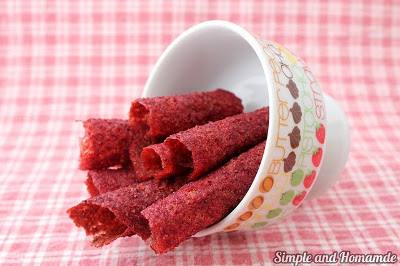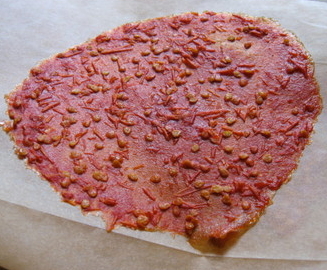
Fruit leather
 If you are new to drying and
like the flavor of dried fruit, I highly recommend starting with
leather. Fruit leather tends to be faster, easier, and tastier
than whole dried fruit because:
If you are new to drying and
like the flavor of dried fruit, I highly recommend starting with
leather. Fruit leather tends to be faster, easier, and tastier
than whole dried fruit because:
- The fruit is pureed, so you can mix in lemon juice and not worry about dipping fruits in sulfur or ascorbic acid to stop enzymes from degrading your dried food.
- I've found that it's much faster to take off the stems and skins, remove seeds or pits, and toss the fruit in the processor than to carefully slice pieces of equal thickness and lay them on the tray.
- There's no need to worry about checking (a process of piercing the skin of whole fruits like blueberries and strawberries so that moisture can escape.)
- You can run pureed berries through a foley mill and dry even very
seedy fruits like raspberries.
- Once you jiggle the tray, the puree spreads out evenly, so you don't have to pick off pieces that dry faster and seldom have to flip anything over.
- The thin layer of fruit puree dries faster than slices of fruit.
- Fruit leather is even tastier than fruit dried whole. This
is especially true since you can add a little bit of sweetening without
going through the elaborate glacé process.
 I've walked you through
making peach
leather and strawberry
leather, so I won't
give step by step instructions here. Instead, here are some ideas
for making fruit leather even more exciting:
I've walked you through
making peach
leather and strawberry
leather, so I won't
give step by step instructions here. Instead, here are some ideas
for making fruit leather even more exciting:
- Mix and match fruits.
Adding applesauce to other fruits helps make low pectin fruit leathers
rollable, but you can also think about mixing fruits from a flavor
point of view. You can even add small chunks of other kinds of
fruit to the puree.
- Add seasoning. I've been adding a bit of lemon and honey to my fruit leathers, and that really helps turn them into the kind of snack Mark will drag off to his lair. I also want to experiment with adding a bit of lemon zest (1 tsp per quart of puree), and perhaps making a "butternut pie" leather with pie spices. When adding seasonings to fruit leather, though, you should be aware that a little goes a long way since the puree will dry down to a much more condensed package.
- Add garnishes. My breakfast is usually fruit and nuts, so I'm excited to try adding some seeds or chopped nuts to my leather for instant meals.
- Make fun shapes. If you've got kids in your household, DeLong suggests making fruit leather shapes by pouring puree into open-topped cookie cutters. You can remove the cutter and use it over and over as long as the puree is thick enough.
- Try vegetable leather.
DeLong has recipes for several sweet-potato-based leathers in her book,
but I'm envisioning a sun-dried tomato, garlic, and basil leather.
Aren't you just itching
to try out some new fruit leather ideas? I know I am!
Want to homestead but don't
know where to start? Our 99
cent ebook helps you
get your feet wet without getting overwhelmed.
| This post is part of our How to Dry Foods lunchtime series.
Read all of the entries: |
Want more in-depth information? Browse through our books.
Or explore more posts by date or by subject.
About us: Anna Hess and Mark Hamilton spent over a decade living self-sufficiently in the mountains of Virginia before moving north to start over from scratch in the foothills of Ohio. They've experimented with permaculture, no-till gardening, trailersteading, home-based microbusinesses and much more, writing about their adventures in both blogs and books.
Want to be notified when new comments are posted on this page? Click on the RSS button after you add a comment to subscribe to the comment feed, or simply check the box beside "email replies to me" while writing your comment.
RSS
comment 1
Have you tried yogurt mixed in? I'm thinking about it.....
Comment by
fostermamas
— Sat Jun 11 01:41:00 2011
- Remove comment
Yogurt in fruit leather
I haven't tried it, but another reader commented about how he mixes pumpkin and yogurt, and I'm considering trying that with our excess butternuts. It sounds worth a shot!
Comment by
anna
— Sat Jun 11 08:43:24 2011
- Remove comment
Add a comment
